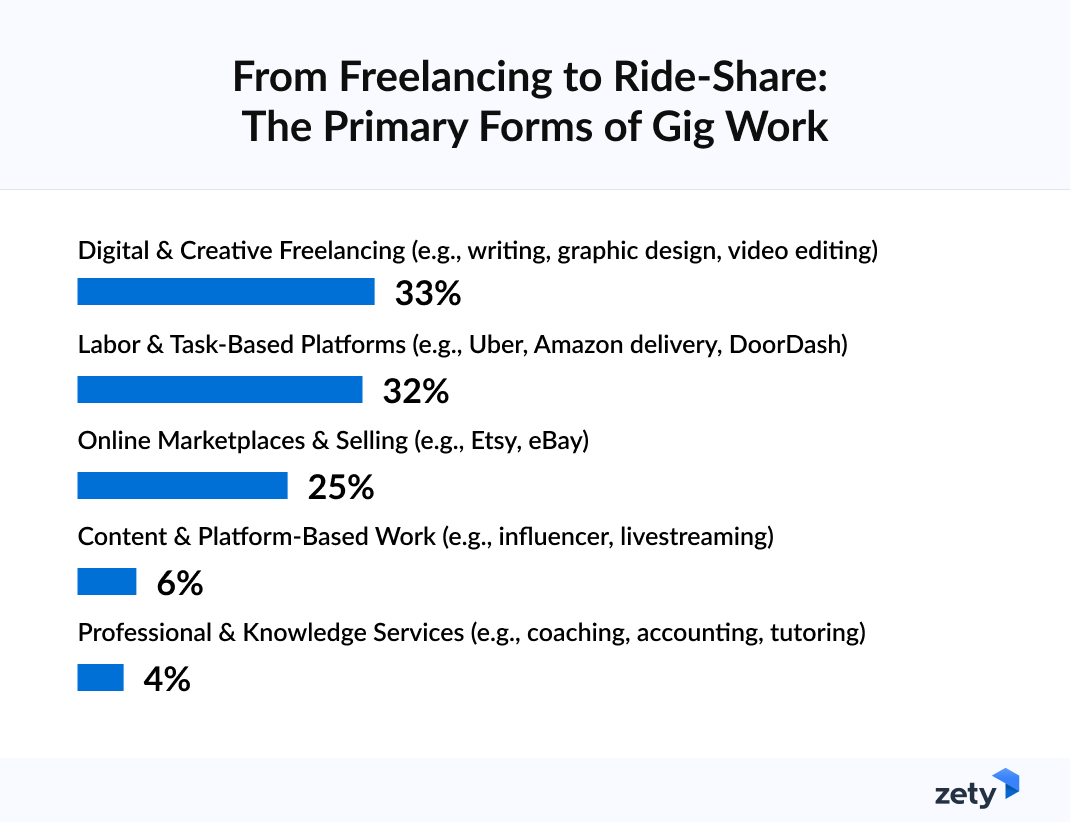
As inflation squeezes budgets, gig workers across the U.S. are hustling harder than ever. Zety’s 2025 State of Gig Work Report uncovers the financial pressures and vulnerabilities shaping the lives of gig workers nationwide.
In a June 2025 survey reflecting current gig economy trends, more than 900 U.S. gig workers revealed that 88% have taken on more work to combat rising prices, and nearly half (47%) cited the lack of benefits like health insurance and retirement plans as their biggest concern.
Key findings:
- Workload surge to survive: 88% have taken on more gigs because of inflation and rising living costs.
- Heavy dependence on gig income: 55% rely on gig work for more than half their total earnings.
- Benefits gap leaves workers exposed: 47% fear lack of health insurance and retirement plans, while 24% say they can’t always cover basic living expenses.
- Platform instability is rampant: 91% report being deactivated, penalized, or shadowbanned without explanation.
- Algorithm manipulation is a survival tactic: 95% say they “game” platform systems to secure better pay or more jobs.
- Burnout risk is real: 33% cite physical or mental burnout as a major concern.
The Most Popular Types of Gig Work
While gig roles span multiple industries, a few dominate the landscape:
- 33%: Digital & creative freelancing (e.g., writing, graphic design, video editing)
- 32%: Labor & task-based platforms (e.g., Uber, Amazon delivery, DoorDash)
- 25%: Online marketplaces & selling (e.g., Etsy, eBay)
- 6%: Content & platform-based work (e.g., influencer, livestreaming)
- 4%: Professional & knowledge services (e.g., coaching, accounting, tutoring)
What this means: Gig work may be diverse, but it’s concentrated in a few high-demand areas. Creative freelancing leads the pack, closely followed by physical delivery and ride-share jobs, showing that both digital skills and hands-on labor dominate the gig economy.
What Gig Workers Worry About Most
The gig economy’s flexibility comes with trade-offs. Many workers worry about inconsistent income, the absence of protections, and the threat of deactivation by platforms.
Their biggest fears include:
- 47%: Lack of benefits such as health insurance and retirement plans
- 35%: Getting deactivated or banned by a platform
- 33%: Physical or mental burnout
- 24%: Not earning enough to cover basic living expenses
- 21%: No job security or consistent income
- 12%: Lack of legal protections or worker rights
What this means: Flexibility comes at the cost of security, leaving workers vulnerable to sudden income loss, burnout, and platform bans. The dependence on systems they don’t control makes gig work uniquely unstable compared to traditional jobs.
Financial Stability in the Gig Economy
55% of workers rely on gig work for more than half their total earnings:
- 5%: Earn 0%–25% of their income from gig work
- 40%: Earn between 26% and 50%
- 46%: Earn between 51% and 75%
- 9%: Rely on gig work for 76%–100% of their income
What this means: For many, gig work is now their main source of income rather than a side job. This reliance means even small disruptions, like algorithm changes or seasonal slowdowns, can threaten financial stability.
Gig Platforms Challenges
91% report being deactivated, penalized, or shadowbanned without clear explanations. Many say they still need to “game” the system to get better jobs or pay:
- 57%: Do so frequently
- 38%: Do so occasionally
- 5%: Never game the system
What this means: Unclear penalties and algorithm-driven job access create a major power imbalance between platforms and workers. The fact that most feel forced to game the system shows how little transparency and trust exist in the gig economy.
Behind the numbers are people balancing opportunity with uncertainty. For gig work to deliver on its potential, workers need more stability, clearer protections, and fairer systems that reward effort over algorithmic luck.
For press inquiries, contact Skyler Acevedo, Public Relations Specialist, at skyler.acevedo@bold.com.
Methodology
The findings presented are based on a nationally representative survey conducted by Zety on June 19, 2025. This gig economy survey collected responses from 903 gig workers across the U.S., examining their experiences with gig work, financial stability, platform challenges, and benefits access. Participants answered a mix of yes/no questions, scale-based items to measure agreement or frequency, and multiple-choice questions allowing selection of multiple responses. To qualify, respondents had to report currently having at least one gig job (defined as temporary, flexible work typically paid per task or project rather than a traditional salaried position) at the time of the survey.
About Zety
Zety resume templates and Zety's resume and cover letter generator are trusted by 12 million users each year. With 100s of options to choose from, including professionally designed resume templates to beat the ATS, users can create a professional resume in less than 15 minutes. Since 2016, Zety’s career blog has provided free data-driven insights to over 40 million readers annually, empowering professionals at every stage. The editorial team includes Certified Professional Resume Writers, with the best career advice and evidence-based findings featured in Business Insider, CNBC, and Forbes, among others. Follow Zety on Facebook, LinkedIn, YouTube, X, and Instagram for free expert career tips and updates.


